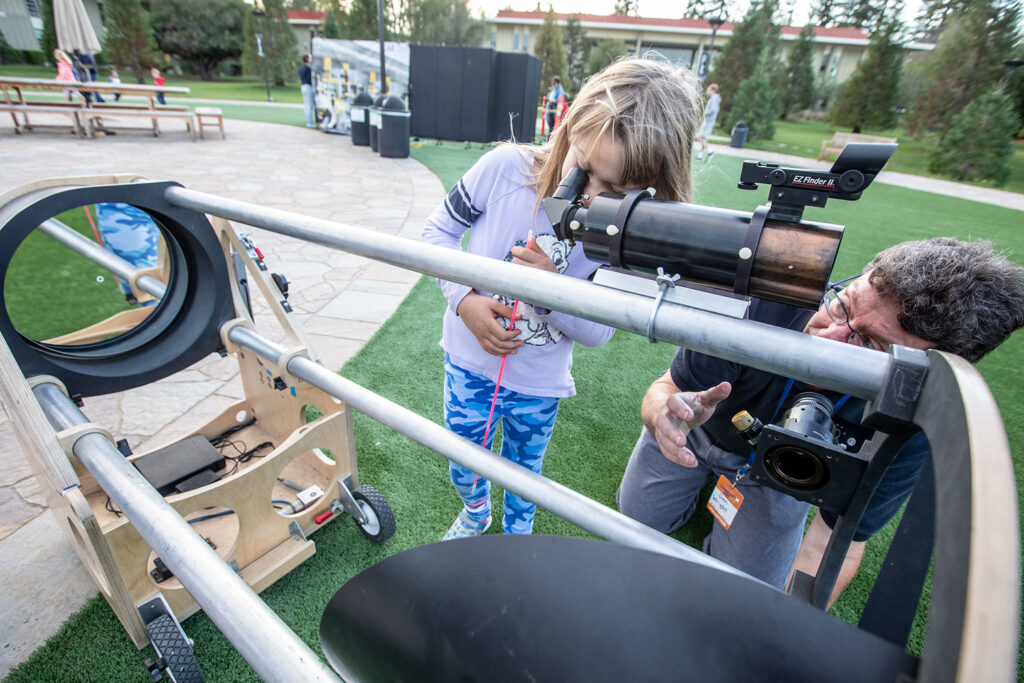KIPAC celebrates 20 years of research
To mark the milestone, the Kavli Institute for Particle Astrophysics and Cosmology (KIPAC) will host an astronomy festival featuring live science demonstrations, hands-on activities, mini science lectures, and more.
This year, the Kavli Institute for Particle Astrophysics and Cosmology (KIPAC) is celebrating two decades of scientific discoveries and achievements at Stanford. To kick off the celebrations, the institute will host the 20th Anniversary Community Day on Saturday, April 15. The festival will feature fun, hands-on science activities, and demonstrations, as well as mini science lectures by KIPAC scientists.

The KIPAC 20th Anniversary Community Day will include two hair-raising Van der Graaf generators. (Image credit: Jacqueline Ramseyer Orrell/SLAC National Accelerator Laboratory)
“All of us at KIPAC are thrilled to mark this anniversary and eager to share the science that we enjoy so much with the community,” said Risa Wechsler, director of KIPAC and professor of physics in the School of Humanities & Sciences. “One of my core beliefs is that all of us should have the opportunity to understand the universe, and I hope attendees at Saturday’s event will walk away with a better understanding of how it works and how they fit into it.”
The festival will take place from 1 to 5 p.m. at the Stanford Science and Engineering Quad (on Via Ortega between Via Pueblo and South Service Rd.) and the Hewlett Teaching Center (at 370 Jane Stanford Way). The event is free, family-friendly, and open to the public. While walk-ins are welcome, online registration is strongly encouraged.
Community Day
Throughout the day, festivalgoers will make their way to various stations to participate in fun science activities related to physics and astronomy. For example, the “Solar S’mores” station will demonstrate how to use a parabolic mirror to focus sunlight to roast marshmallows, and the “Gravity Simulator” station will explain how massive bodies warp the stretchy fabric of “spacetime” and affect the orbit of nearby objects.
Attendees will get to observe the sun through solar H-alpha telescopes and sun-spotters. They’ll also get to interact with an electric field charged by two Van de Graff generators, which will cause their hair to rise, and then have the width of their hair measured by a laser. Attendees can even create their own model of a rotating neutron star, or pulsar, using Play-Doh and LED lights.
KIPAC scientists will also lead live science experiments. For example, during the “Cloud Chamber” demonstration, participants will observe cosmic ray particles in a cloud chamber. And the “Ruben’s Tube” experiment will show how wave patterns change.
Festivalgoers are also encouraged to attend the “Ask an Astrophysicist” event, where KIPAC astrophysicists will answer questions.
Mini lectures
The festival will include several 15-minute mini lectures, suitable for middle-school students and above. Lectures will cover such topics as supermassive black holes and how scientists find them, measuring the unseen parts of the universe with strong gravitational lenses, and the origins of the first stars in the universe. Wechsler will deliver the keynote lecture called “Learning about Dark Matter from the Tiniest Galaxies in the Universe.”
Throughout the year, KIPAC hosts a public lecture series that covers frontier topics. Lectures occur monthly, both in person and online, and are open to the public. Each lecture is followed by a Q&A with astrophysicists. Past lectures are available to view on the KIPAC Youtube channel. KIPAC will also host a three-part lecture series from May to July that will discuss dark matter detection.
Twenty years of research
Founded in 2003, KIPAC is one of 19 independent research labs, centers, and institutes at Stanford that is operated by the Office of the Vice Provost and Dean of Research. It is a community of more than 150 scientists who explore new fronts and challenges in astrophysics and cosmology through theory, computation, experiments, and observations.

Attendees at the KIPAC 20th Anniversary Community Day festival will observe the sun through telescopes and sun-spotters. (Image credit: Jacqueline Ramseyer Orrell/SLAC National Accelerator Laboratory)
KIPAC researchers have made wide-ranging contributions to astrophysics and cosmology over this period, including leadership of the Fermi Gamma-Ray Space telescope, the study of distant galaxies and their impact on cosmic structure through the Dark Energy Survey, and the characterization of hundreds of extrasolar planets. KIPAC researchers are also involved in the development of the Legacy Survey of Space and Time (LSST), an upcoming 10-year survey of the southern sky that will take place at the Vera C. Rubin Observatory, currently under construction on the El Peñon peak of Cerro Pachón in northern Chile. The survey will use multiple techniques to measure and study dark energy, the putative driving force of cosmic acceleration, and will also make a movie of everything that changes in the sky, with the ability to discover many new kinds of astronomical events.
“KIPAC scientists are dedicated to investigating the mysteries of the universe and its constituents – from the very small to the very large,” Wechsler said. “I am proud of all that our institute has achieved over the last twenty years and excited about the discovery potential of the next decade of astronomical data.”
Further details about Saturday’s festival, including a list of activities, are available on the KIPAC website.